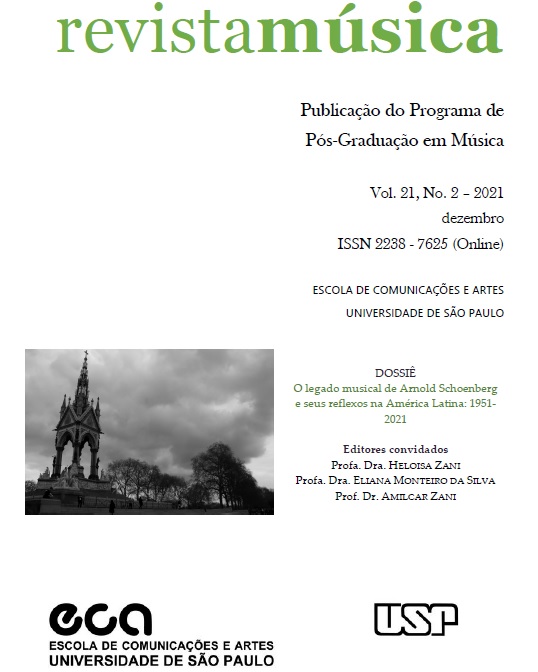What a Lied of Schoenberg can teach us about a Sonata of Santoro?
DOI:
https://doi.org/10.11606/rm.v21i2.193558Keywords:
Twelve-tone music, Serial analysis, Atonalism, Schoenberg's songs, Santoro's sonatasAbstract
The analysis of Arnold Schoenberg’s song Sommermüg Op.48 N.1 show us that the dodecaphonic techniques employed by the composer, in a period when the method had already reached its maturity, exhibit a larger variety of compositional strategies than textbooks teach us. The segmentation of the series in pitch sets with complementary functions of melodic counterpoint and of harmonic support is one of them. His search for symmetrical constructions is another concern to which we use to give less attention than the composer had whished.
The analysis of Schoenberg’s music allowed us the revisit Claudio Santoro’s Sonata 1942 for piano, one of the pioneer Brazilian pieces of music in the dodecaphonic style. The detailed exam of the technique of the work reveals a young composer already with complete control of the dodecaphonic method, what lead us to guess the motives that induced our musicology to charge him with lack of knowledge and disregard for the style’s orthodoxy.
We concluded that, among other reasons, this unfair critique was motivated by an academic preference for the style of Webern, an author who, at that moment, could not have been used by Santoro as a model.
Downloads
References
ANTOKOLETZ, Elliot. Twentieth-Century Music. New Jersey: Prentice-Hall, 1992.
BABBITT, Milton. “Twelve-Tone Invariants as Compositional Determinants”. Musical Quaterly 46, p. 246, 1960.
CAPLIN, William. Classical Form. New York: Oxford University Press, 2000.
EIMERT, Herbert. ¿Qué es la Música Dodecafónica? Buenos Aires: Nueva Visión, 1952/1973.
GADO, Adriano Braz. “O Serialismo na Sonata 1942 de Cláudio Santoro: Movimento Lento”. Revista Eletrônica de Musicologia, v. 13, p. 1, 2010.
HAIMO, Ethan. Schoenberg’s Transformation of Musical Language. Cambridge: Cambridge University Press, 2006.
HEPOKOSKI, James. Elements of Sonata Theory. New York: Oxford Univerity Press, 2006.
KRENEK, Ernst. Studies in Counterpoint. New York: Schirmer, 1940.
KRENEK, Ernst. “Extents and Limits of Serial techniques”. The Musical Quaterly. Vol. 46, No. 2, p. 210, 1960.
LABORDA, Jose García. Forma y Estructura en la Música del Siglo XX: uma aproximación analítica. Madrid: Alpuerto, 1996.
LARSEN, Juliane Cristina. A Forma Sonata em Três Obras Inaugurais: diálogos da nova música de Berg, Schoenberg e Santoro com a tradição. Prof. Dr. Rodolfo Coelho de Souza (orientador). Dissertação (Mestrado em Música) – Escola de Comunicações e Artes, Universidade de São Paulo, São Paulo: 2010.
LESTER, Joel. Analytic Approaches to Twentieth-Century Music. New York: Norton, 1989.
MARIZ, Vasco. Cláudio Santoro. Rio de Janeiro: Civilização Brasileira, 1994.
MENDES, Sérgio Nogueira. “Cláudio Santoro: serialismo dodecafônico nas obras da primeira fase (1939-1946)”. In: Anais do Congresso de 2001 da Associação Nacional de Pesquisa e Pós-Graduação em Música. Goiânia: Editora da Anppom, 2001.
OLIVEIRA, João Pedro Paiva de. Teoria Analítica da Música do Século XX. Lisboa: Gulbenkian, 1998.
PERLE, George. The Listening Composer. Berkeley: University of California Press, 1990.
ROIG-FRANCOLÍ, Miguel. Understanding Post-Tonal Music. New York: McGraw-Hill, 2007.
SAMPAIO, João Luiz. Claudio Santoro: 100 anos de música. Rio de Janeiro: Funarte, 2019.
SCHOENBERG, Arnold. La Composicion con Doce Sonidos, In: El Estilo y la Idea, p. 142. Madrid: Taurus, 1941/1963.
SCHUIJER, Michiel. Analyzing Atonal Music: Pitch-Class Set Theory and Its Contexts. Rochester: University of Rochester Press, 2008.
STRAUS, Joseph N. Twelve-Tone Music in America. Cambridge: Cambridge University Press, 2009.
WHITTALL, Arnold. Serialism. Cambridge: Cambridge University Press, 2008.
WUORINEN, Charles. Simple Composition. New York: Peters, 1979.
Downloads
Published
Issue
Section
License
Copyright (c) 2021 Rodolfo Coelho de Souza

This work is licensed under a Creative Commons Attribution-NonCommercial-ShareAlike 4.0 International License.
Autores que publicam nesta revista concordam com os seguintes termos:
- Autores mantém os direitos autorais e concedem à revista o direito de primeira publicação, com o trabalho simultaneamente licenciado sob a CC Attribution-NonCommercial-ShareAlike 4.0 que permite o compartilhamento do trabalho com reconhecimento da autoria e publicação inicial nesta revista.
- Autores têm autorização para assumir contratos adicionais separadamente, para distribuição não-exclusiva da versão do trabalho publicada nesta revista (ex.: publicar em repositório institucional ou como capítulo de livro), com reconhecimento de autoria e publicação inicial nesta revista.
- Autores têm permissão e são estimulados a publicar e distribuir seu trabalho online (ex.: em repositórios institucionais ou na sua página pessoal) a qualquer ponto antes ou durante o processo editorial, já que isso pode gerar alterações produtivas, bem como aumentar o impacto e a citação do trabalho publicado (Veja O Efeito do Acesso Livre).


